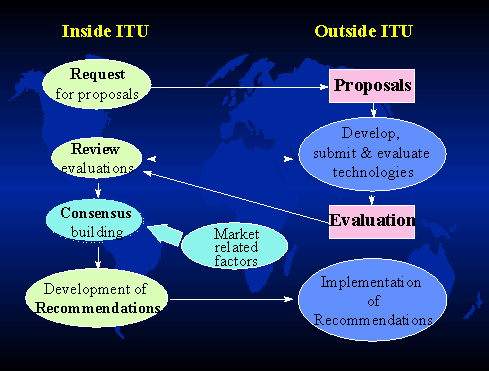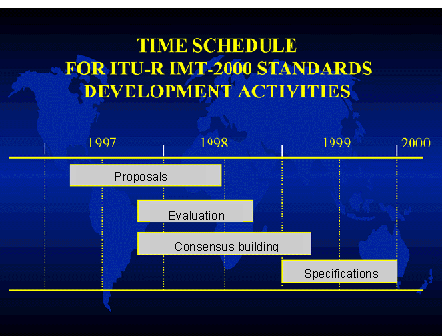
ITU Works Towards Global Standards for Mobile Telecommunications
23 October 1997
Geneva – Global standards for third generation mobile telecommunications have moved a step closer towards becoming a reality following meetings in September of several groups concerned with the development of the new standard, known as International Mobile Telecommunications 2000 (IMT-2000).
IMT-2000 is an initiative of the International Telecommunication Union (ITU) which aims to integrate the various satellite, terrestrial, fixed and mobile systems currently being deployed and developed under an ‘umbrella standard’ that will pave the way towards true global service capabilities and interoperability soon after the year 2000.
Evolution of 2nd Generation Mobile Systems to IMT-2000
By the year 2000, 2nd generation mobile radio systems (such as cordless and cellular systems, generally referred to as ‘pre-IMT2000’ systems) will be in place throughout most of the world, implemented through different radio environments and technologies. IMT-2000 is designed to be able to connect different radio transmission modules to the same core network equipment. This will facilitate evolution of pre-IMT-2000 systems towards IMT-2000. The goal of third generation mobile systems is to provide users with worldwide coverage via handsets which have the capability to seamlessly roam between multiple networks – fixed and mobile, cordless and cellular – across regions which currently use different technologies.
Radio Transmission Technologies
Radiocommunication Task Group 8/1 convened in Toronto, Canada, for a meeting and workshop on new Radio Transmission Technologies (RTTs). As well, Study Group 11 of the ITU’s Telecommunication Standardization Sector (ITU-T), which is the lead ITU-T study group for IMT-2000, and Study Group 13 of the Telecommunication Standardization Sector, which is the lead study group for the development of the Global Information Infrastructure, both met in Geneva last month.
The meeting of Task Group 8/1, hosted by Bell Mobility, built on the progress already made at the meeting in Cheju, South Korea last February to define the vast array of standards needed to make up IMT-2000. During the course of the event, a Recommendation was established which defines the IMT-2000 system model, detailing the levels of modularity and the commonality of the system. As well, substantial progress was made on related regulatory and administrative issues which will be important to the implementation of IMT-2000. Finally, the meeting prepared an enhanced listing and definition of services expected to be offered under the new system.
The workshop on Radio Transmission Technologies (RTTs) for IMT-2000 held in conjunction with the Task Group 8/1 meeting followed the ITU’s formal request in April 1997 for submission of candidate technologies by members of the ITU’s Radiocommunication Sector. The deadline for submissions to ITU is 30 June 1998. Evaluation of the proposals will be undertaken by ITU membership, regional standards organizations and independent evaluation groups, who are required to submit their reports to Task Group 8/1 by 30 September 1998.
Selection of technologies will be made on the basis of an iterative consensus-building process. Choices will reflect the best possible outcome based on combinations of the various proposals, since it is unlikely that any single proposal will be the best for all IMT-2000 radio operating environments and services (see Figures 1 & 2).
The choice of radio transmission technologies for IMT-2000 will be very important in defining the way in which different systems interoperate, or ‘talk’ to one another. Mr Michael H. Callendar, Chairman of Task Group 8/1, emphasized the importance of flexible transmission standards for IMT-2000, in order to ensure that the system is dynamic and robust enough to cope with an evolving communications environment. "With the rapid changes in technology, particularly in the digital processing area, the new standards we develop for IMT-2000 must not be restrictive; rather, they should promote future telecommunication enhancements. In other words we must standardize the right things, so that the flexible radio bearers which provide wireless access can be efficiently controlled by future applications that we haven’t even dreamt about today."
FIGURE 1

The present work schedule calls for the ‘key choices’ of radio transmission technologies associated with IMT-2000 to be made by March 1999, with appropriate ITU Recommendations to be completed by the year 2000.
IMT-2000 is being developed in recognition of the fact that future wireless access systems will need to provide users with the same high quality and broadband characteristics offered by fixed networks. Mobile voice, fax and data is a rapidly growing segment of the telecommunications market, and is expected to represent a very substantial proportion of telecommunications traffic in years to come. With a growth rate of almost five million new mobile users a month, wireless access has already overtaken fixed networks in terms of new subscribers. Wireless technologies will also play a major role in personal access to tomorrow’s Global Information Infrastructure (GII).
As wireless becomes a major part of global telecommunications, common network components need to be developed which can provide virtually any desired future service combination between wired or wireless access links. The IMT-2000 wireless access standard aims to provide universal coverage, allowing mobile terminals to move about seamlessly between any type of network. While the plans for the new standard envisage a small, lightweight pocket communicator, IMT-2000 will support a very wide range of terminal products, from simple messaging units through to desktop multimedia terminals.
Under the IMT-2000 model, mobile telephony will no longer be based on a range of market-specific products, but will be founded on common standardized flexible platforms, which will meet the basic needs of major public, private, fixed and mobile markets around the world. This approach should result in a longer product life cycle for core network and transmission components, and offer increased flexibility and cost effectiveness for network operators, service providers and manufacturers.
FIGURE 2

The need to provide for future, non-standardized telecommunications services which can be created in a competitive, multi-operator environment places radically new requirements on the radio interface. Under current plans for IMT-2000, a user's application – say, a mobile e-mail system, Internet browser or videoconferencing system – will automatically negotiate to secure channels in each direction with the required characteristics of bandwidth, delay and quality. The elements of the radio interface (such as the channel coder, modulator, transcoder and so on) will no longer have fixed parameters; rather, they will be in the form of a ‘toolbox’ whereby the bandwidth, transmission quality and delay can be selected, negotiated, and mixed and matched, according to the requirements of the service being delivered.
"Work on new standards for global telephony within the ITU has been driven, in part, by a need for rapid improvement in the quality and level of access to global telecommunications, particularly for developing countries," said Robert Jones, Director of the ITU’s Radiocommunication Bureau. "This new IMT-2000 standard aims to exploit the potential synergy between the digital mobile telecommunications technologies being developed as part of the dramatic growth of personal telecommunications, and those rapidly evolving for fixed wireless access."
"With the development of appropriate ITU global standards, and harmonized assignment of spectrum by the various national and regional authorities within the framework of the internationally agreed spectrum allocations in the ITU Radio Regulations, we can move from today's collection of unique mobile systems, each with its own standards, different range of services and specific allocation of radio spectrum, towards the future world of global personal mobile telecommunications in which a single inexpensive mobile terminal can truly provide communications ‘anywhere - anytime’," he said.
IMT-2000 is intended to operate worldwide soon after the year 2000 in the 1 885 – 2 025 MHz and 2 110 – 2 200 MHz bands, with the satellite component limited to the 1 980 – 2 010 MHz and 2 170 – 2 200 MHz bands. The radio frequency spectrum allocations needed to make IMT-2000 a reality were made by the ITU’s World Administrative Radio Conference held in Torremolinos, Spain, in 1992, which identified 230 MHz of spectrum for IMT-2000 in the 2 GHz band.
To date, the ITU has approved more than a dozen Recommendations (international voluntary standards) relating to IMT-2000. The IMT-2000 standards development project is a team effort involving the Union, representatives from regional and national standards organizations, and members of the global telecommunications industry such as regulators, operators and manufacturers.
The ITU Radiocommunication Assembly being held this week in Geneva (20-24 October) approved today a critical standard providing the framework for modularity and radio commonality within IMT-2000. The standard will facilitate the development of a modular framework which will serve as the foundation on which different ‘flavours’ of mobile communications system can be based, as well as allowing different platforms to be combined in different ways to meet the special needs of operators. This standard will give the long-awaited go-ahead to manufacturers and operators for the co-ordinated development of IMT-2000 strategies.
For more information on IMT-2000, contact Mr Fabio Leite, Counsellor, IMT-2000, tel: +41 22 730 5940, fax: +41 22 730 5816, e-mail: fabio.leite@itu.int, or consult the IMT-2000 Web site at: http://www.itu.int/imt.